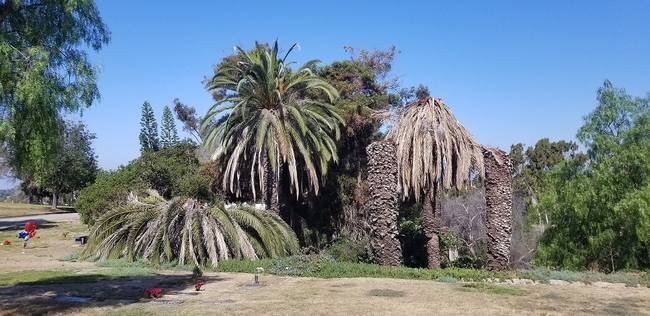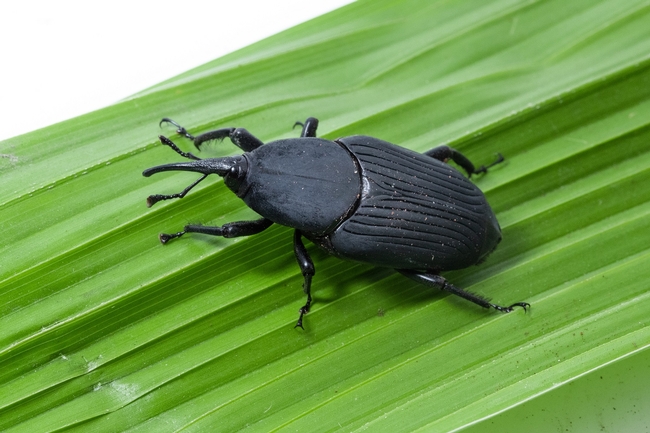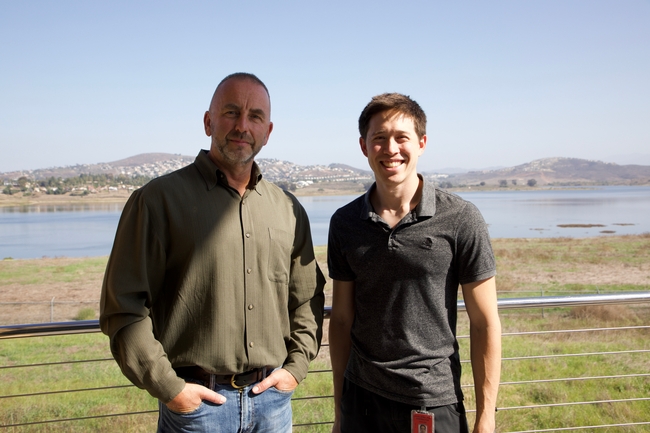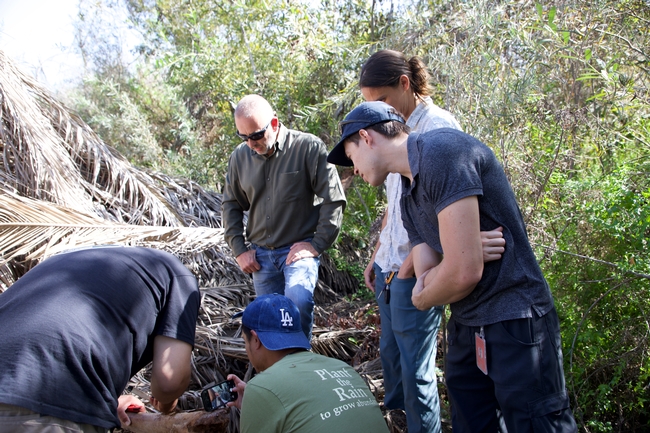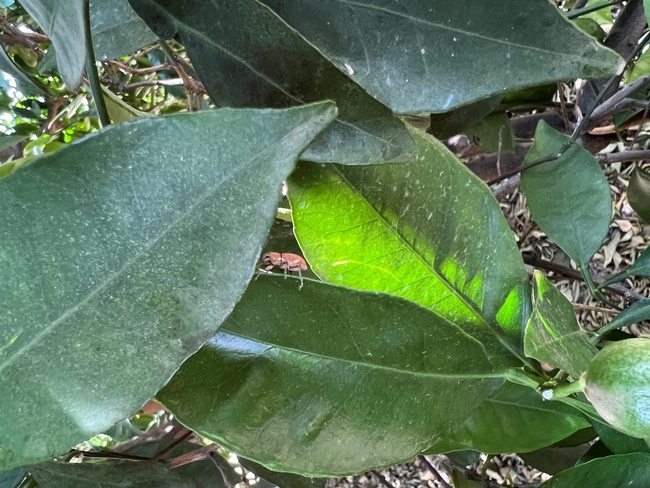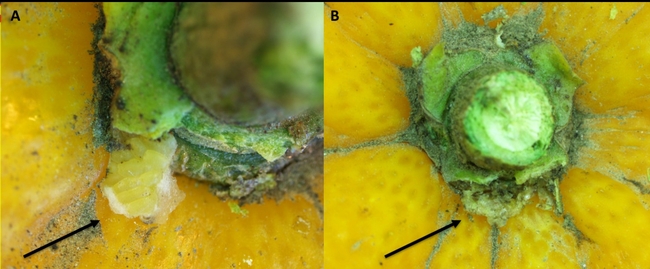Posts Tagged: weevil
Lawn-pocalypse! Surviving Drought
Ah, summer! The season of sunburns, pool parties, and… lawn droughts. If your once lush, green carpet now looks like a crunchy brown doormat, you're not alone. Let's dive into why your yard is staging a dramatic death scene and what you can do to...

Bermuda grass and weeds overtaking drought stressed turf grass.
Palm weevil threatens So Cal palm trees
More than 20,000 palms in the region have been killed by South American palm weevil
The swaying palm trees that line San Diego's streets might not be swaying much longer due to a pest that is infecting many of these iconic trees and making its way across Southern California.
The South American palm weevil (SAPW), also referred to as the American palm weevil and black palm weevil, was first detected in San Diego County in 2011, with breeding populations found in a Canary Island date palm in San Ysidro in 2015. According to industry experts, more than 20,000 palms in the region have been killed by SAPW thus far.
While SAPW can attack a variety of palm tree species, Canary Island date palms (Phoenix canariensis) are by far their most preferred host. SAPW adults lay their eggs in the crown of palm trees and then larvae hatch and voraciously consume the growing tissue of the palm. If left unchecked, this pest can kill mature palms in a matter of months.
SAPW has affected neighborhoods and cities throughout the greater San Diego area, creating a need for more residents to be aware of this concern and report infected palms. Though infestation has not been confirmed, SAPW adults have been reported in the Coachella Valley – about 120 miles northeast of San Diego.
‘Super-dispersers' from San Diego can fly long distances
The California Department of Food and Agriculture has trapped weevils in the Coachella Valley and recent posts on iNaturalist, a social network for community members to map and share observations of biodiversity across the globe, indicate that adult weevils are flying into areas where edible dates are grown.
These reports interest researchers like Mark Hoddle, University of California Cooperative Extension based at UC Riverside, because the Coachella Valley, the major production area for edible dates nationwide, is far from any known infested palm trees.
How did the weevils get there? “It may be super-dispersers from San Diego,” said Hoddle. “They are on a death mission when they fly long distances – find food or die trying!”
While conducting an experiment to assess SAPW's flight capability, Hoddle and his team learned that the beetle could fly non-stop for up to five hours, with some variation between males and females. “In some cases, they will fly until they die,” Hoddle said.
Currently, Hoddle is managing an ongoing urban palm surveillance effort of 521 palm trees in and around Bonita in San Diego County, which are assessed every six months. More than 70% of these palms have been killed by SAPW over a 6.5-year period.
Although Canary Island date palms are highly preferred by SAPW, the weevils can complete their entire life cycle in sugarcane as well. For palm species that are not currently preferred by the pest, there is still a chance that they can become more preferred over time as SAPW works its way through all available Canary Island date palms in the region.
Taking action to protect your palms
There are steps that one can take to protect palm trees. Traps can be used to both monitor weevils and reduce the number of adults flying around. There are two types of traps that Hoddle has evaluated for weevil captures: the bucket trap and the Picusan trap. Both use a fermenting bait – prepared with dates, baker's yeast and water – that is placed in a glass jar with a perforated lid, in addition to a commercially available aggregation pheromone that will attract male and female weevils.
Of the two trap types, Hoddle prefers Picusan traps because they catch about six times as many weevils as bucket traps – retaining more than 95% of the weevils that are attracted to them. Bucket traps, on the other hand, retain only about 30% of weevils.
Hoddle emphasizes that trap placement is key. The Picusan trap is designed to be placed on the ground, whereas the bucket trap is typically hung from a tree branch, fence or post. Furthermore, the traps should be placed at least 500 yards away from the potential host palms and avoid direct sunlight. Shaded or partially shaded areas are best to avoid diminishing the trap's potency.
Another strategy is to prune palm trees when SAPW flight activity is low (December through March) to minimize attracting flying adult weevils to freshly pruned palms.
Finally, the best way to protect your tree is to apply insecticides. These chemicals will kill adult weevils that attempt to start infestations. While contact insecticides can deter and kill adults when applied to the crown of the palm, systemic insecticides are usually more effective and can be applied as soil and crown drenches, trunk sprays, or soil and trunk injections. Systemic insecticides move inside the palm and concentrate in the palm heart, the growing area at the top of the palm where weevils feed. Once this growing area is damaged by feeding weevil larvae, palms die.
“Just know that if you are planning to protect palms with insecticides, you are in it for life,” saidHoddle, emphasizing that there is no “one and done” approach to saving palms affected bySAPW. “Don't start if you can't commit.
Aesthetics aren't the only motivation to prevent palm infection and death caused by SAPW. Palm crowns that are highly damaged by larval feeding can detach from the top of the trunk and fall to the ground, putting people and property at risk. Dead fronds drop from dying palms and the large spines at the base of the fronds are a significant hazard to people and pets.
Seek expert support for tree concerns and removal
Removing dead palms is an expensive and time-consuming process. Removal can cost between $2,400 to $4,000 per palm, with cost varying based on location. For example, if a palm is in an area that requires the use of a crane, semitruck or helicopter to safely access, remove and dispose of the dead palm, tree removal can cost up to $15,000.
Once a palm is infested with SAPW, it likely cannot be saved unless it is aggressively treated with insecticides at an early stage of the infestation. If you are certain that a tree is infected by SAPW, it is highly recommended that you work with a tree care company or arborist to manage the weevils that might be present in the palm and to promptly and responsibly dispose of dead palms so that spread of weevils into new areas is minimized.
To confirm visual signs of palm trees that have been affected by SAPW, visit Hoddle's site for more information and to report infested palms: https://cisr.ucr.edu/invasive-species/palmarum-survey.
To read this story in Spanish, visit: https://ucanr.edu/blogs/blogcore/postdetail.cfm?postnum=58381
Fuller Rose Beetle Sampling Protocol
USDA-APHIS Approves New Fuller Rose Beetle Mitigation – a Voluntary Option to Reduce Pesticide Applications
By
Sandipa Gautam, Area Citrus IPM Advisor UCCE
James R Cranney, President CCQC
At the request of the California Citrus Quality Council (CCQC) USDA's Animal and Plant Health Inspection Service (APHIS) has approved a new sampling protocol that growers can use to reduce pesticide applications for control of Fuller rose beetle (FRB), a quarantine pest in South Korea.
Fuller rose beetles are brown, flightless, snout beetles that have one generation in a year (Figure 1). Three-fourths of their life cycle is spent under the ground where they feed on roots and go through development. Adults emerge from the ground year-round, but the major emergence in the San Joaquin Valley occurs July-September, with 53% of beetles emerging in August. All beetles are females and adult females do not require mating to begin reproduction. Beetles climb to the tree canopy and feed on citrus leaves and lay eggs on cracks and crevices including the under the sepal (Figure 2). Eggs can be present at the time of harvest, thereby making this beetle a quarantine concern for Korea's Animal and Plant Quarantine Agency.
Figure. 1. Fuller rose beetle adult (right there, centered in the triangle).
Figure 2. Fuller rose beetle egg masses, live eggs (A) – note yellowish and plump eggs; dead or hatched eggs (B) – dried out egg mass.
Current Practices for FRB Management
Growers have been using a system's approach which combines cultural and chemical methods to target FRB, since 2010. The goal of FRB management is to reduce the beetle population and egg laying. Current regulatory requirements for managing FRB are
a) Skirt Pruning sufficient to prevent tree skirts from contacting the ground
b) Weed control sufficient to prevent forming a bridge from ground to tree skirt
c) Two insecticide treatments to control Fuller rose beetle using only University of California recommended pesticides from the UCANR IPM Guidelines web page at http://ipm.ucanr.edu/PMG/r107300311.html
In recent years, most growers and pest control advisors have reported that they no longer detect beetles in most citrus groves. Furthermore, the USDA APHIS interception rate from phytosanitary inspections, where 600 fruits per container are sampled for FRB egg masses, FRB was found in only 0.05 percent of all containers. This indicates that FRB populations are very low in citrus groves.
Since FRB populations in citrus groves are historically low, CCQC has proposed an additional voluntary option for the Korea FRB Protocol to reduce pesticide use:
- Trees must be skirt pruned to minimize branches touching the ground.
- Herbicide treatments should be made to eliminate weeds that could be a pathway into the tree.
- Either option a or option b
a) Growers must make two pesticide applications to control FRB using pesticides recommended on the University of California Citrus IPM website https://ipm.ucanr.edu/agriculture/citrus/fuller-rose-beetle/
b) Growers must use the FRB sampling protocol (below), keep records and if no more than two FRB-infested trees per sample are detected they may eliminate the first application and make one application, preferably before October 31 with pesticides recommended on the citrus IPM website.
Fuller Rose Beetle Sampling Protocol:
- Growers should conduct Fuller rose beetle (FRB) sampling from Aug. 7 – Aug. 31 since that is the peak period of emergence.
- Conduct a random sample in each citrus block.
- Divide the block into four quadrants and sample 18 trees that are spread equally apart in each quadrant. A total number of trees sampled is 72 trees.
- Growers or Pest Control Advisors (PCA) should:
i. Check suckers inside the tree for signs of FRB leaf chewing and if beetles are detected the tree is considered infested.
ii. If no beetles are found in the interior, shake two large outside branches over a light cloth and inspect for FRB. If beetles are found, the tree is considered infested.
- Growers must keep records on the results of the sampling including (i) block identification, (ii) inspection date, (iii) name of inspector, and (iv) number of trees infested with beetles out of 72 trees inspected.
- If no more than two infested trees are found, growers may eliminate the first FRB pesticide application. If two infested trees are found, growers must make a pesticide application in August or early September.
- If no more than two infested trees are found, growers are still required to make one pesticide application to control FRB, preferably before October 31.
How will the new protocol help?
- Reduced pesticide use could reduce grower costs to manage FRB.
- Fewer pesticide applications should improve biological control in citrus groves by preserving beneficial insects. Many PCAs and growers attribute severe mealy bug outbreaks to increased pesticide use to control FRB and Asian citrus psyllid.
- Reducing pesticide use to control FRB will help California citrus growers adopt more sustainable production practices and align the industry with the California Department of Pesticide Regulation's Sustainable Pest Management Roadmap.
References:
UCIPM 2017. Citrus Pest Management Guidelines: Fuller Rose Beetle. https://ipm.ucanr.edu/agriculture/citrus/fuller-rose-beetle/
Climate-Change Resources
University of California UC ANR Green Blog (Climate Change and Other Topics) https://ucanr.edu/blogs/Green/index.cfm?tagname=climate%20change (full index)
Examples:
- Save Trees First: Tips to Keep Them Alive Under Drought https://ucanr.edu/b/~CdD
- Landscaping with Fire Exposure in Mind: https://ucanr.edu/b/~G4D
- Cities in California Inland Areas Must Make Street Tree Changes to adapt to Future Climate https://ucanr.edu/b/~oF7
Drought, Climate Change and California Water Management Ted Grantham, UC Cooperative Extension specialist (23 minutes) https://youtu.be/dlimj75Wn9Q
Climate Variability and Change: Trends and Impacts on CA Agriculture Tapan Pathak, UC Cooperative Extension specialist (24 minutes) https://youtu.be/bIHI0yqqQJc
California Institute for Water Resources (links to blogs, talks, podcasts, water experts, etc.) https://ciwr.ucanr.edu/California_Drought_Expertise/
UC ANR Wildfire Resources (publications, videos, etc.) https://ucanr.edu/News/For_the_media/Press_kits/Wildfire/ (main website)
-UC ANR Fire Resources and Information https://ucanr.edu/sites/fire/ (main website)
-Preparing Home Landscaping https://ucanr.edu/sites/fire/Prepare/Landscaping/
UC ANR Free Publications https://anrcatalog.ucanr.edu/ (main website)
- Benefits of Plants to Humans and Urban Ecosystems: https://anrcatalog.ucanr.edu/pdf/8726.pdf
-Keeping Plants Alive Under Drought and Water Restrictions (English version) https://anrcatalog.ucanr.edu/pdf/8553.pdf
(Spanish version) https://anrcatalog.ucanr.edu/pdf/8628.pdf
- Use of Graywater in Urban Landscapes https://anrcatalog.ucanr.edu/pdf/8536.pdf
- Sustainable Landscaping in California https://anrcatalog.ucanr.edu/pdf/8504.pdf
Other (Non-UC) Climate Change Resources
Urban Forests and Climate Change. Urban forests play an important role in climate change mitigation and adaptation. Active stewardship of a community's forestry assets can strengthen local resilience to climate change while creating more sustainable and desirable places to live. https://www.fs.usda.gov/ccrc/topics/urban-forests
Examining the Viability of Planting Trees to Mitigate Climate Change (plausible at the forest level) https://climate.nasa.gov/news/2927/examining-the-viability-of-planting-trees-to-help-mitigate-climate-change/
Reports and other information resources coordinated under the auspices of the United Nations and produced through the collaboration of thousands of international scientists to provide a clear and up to date view of the current state of scientific knowledge relevant to climate change. United Nations Climate Action
Scientific reports, programs, action movements and events related to climate change. National Center for Atmospheric Research (National Science Foundation)
Find useful reports, program information and other documents resulting from federally funded research and development into the behavior of the atmosphere and related physical, biological and social systems. Search and find climate data from prehistory through to an hour ago in the world's largest climate data archive. (Formerly the "Climatic Data Center") National Centers for Environmental Information (NOAA)
Think tank providing information, analysis, policy and solution development for addressing climate change and energy issues (formerly known as the: "Pew Center on Global Climate Change"). Center for Climate & Energy Solutions (C2ES)
Mapping Resilience: A Blueprint for Thriving in the Face of Climate Disaster. The Climate Adaptation Knowledge Exchange (CAKE) was launched in July 2010 and is managed by EcoAdapt, a non-profit with a singular mission: to create a robust future in the face of climate change by bringing together diverse players to reshape planning and management in response to rapid climate change. https://www.cakex.org/documents/mapping-resilience-blueprint-thriving-face-climate-disaster
Cal-Adapt provides a way to explore peer-reviewed data that portrays how climate change might affect California at the state and local level. We make this data available through downloads, visualizations, and the Cal-Adapt API for your research, outreach, and adaptation planning needs. Cal-Adapt is a collaboration between state agency funding programs, university and private sector researchers https://cal-adapt.org/
Find reports, maps, data and other resources produced through a confederation of the research arms of 13 Federal departments and agencies that carry out research and develop and maintain capabilities that support the Nation's response to global change. Global Change (U.S. Global Change Research Program)
The Pacific Institute is a global water think tank that combines science-based thought leadership with active outreach to influence local, national, and international efforts to develop sustainable water policies. https://pacinst.org/our-approach/
Making equity real in climate adaptation and community resilience policies and programs: a guidebook. https://greenlining.org/publications/2019/making-equity-real-in-climate-adaption-and-community-resilience-policies-and-programs-a-guidebook/
Quarterly CA Climate Updates and CA Drought Monitor Maps (updated each Thursday) https://www.drought.gov/documents/quarterly-climate-impacts-and-outlook-western-region-june-2022
Drought focus of Water Resources IMPACT magazine special issue
UC ANR experts address emotional toll of drought
Preparing the American West for prolonged drought is the focus of a double issue of Water Resources IMPACT magazine. The California Water Commission staff are guest editors for this special open-access edition of the magazine, which is published by the American Water Resources Association.
Faith Kearns, academic coordinator of University of California Agriculture and Natural Resources' California Institute for Water Resources, is among the authors delving into how drought impacts people and the environment and how we can better prepare for the inevitable.
The first issue, published on Feb. 14, focuses on water scarcity issues confronting California and the ways these issues affect different sectors.
In “Trauma, Care, and Solidarity: Addressing the Emotional Toll of Chronic Drought,” Kearns highlights the effects of drought on mental health. She points to the spike in suicide hotline calls when wells ran dry in Southeast Asian communities in California's Central Valley.
By listening to Southeast Asian farmers, Ruth Dahlquist-Willard and Michael Yang of UC Cooperative Extension were able to “lighten the load” for them by providing pragmatic support, Kearns writes.
“The scale of some of these highly emotional issues – drought, wildfires, climate change – can make them seem incredibly difficult, if not impossible, to deal with,” Kearns said. “At the same time, they are affecting everyone living in the western U.S. on a daily basis. I wanted to highlight and provide models based on work that people – whether they are researchers, clinical psychologists, or Cooperative Extension advisors – are doing right now to ease the way.”
The authors who contributed to the double issue are a diverse array of Tribal experts, academics, nongovernmental organization thought-leaders, water managers and water policy influencers, each of whom brings their own perspective on the topic of drought. Their expertise and perspectives in climate science, water policy and water management will help inform drought-related decision-making and support policies that better prepare the state to thrive during periods of prolonged water scarcity.
In addition to Kearns, the first issue includes articles contributed by:
- Samantha Stevenson, University of California, Santa Barbara
- Jay Lund, University of California, Davis
- Ron Goode, North Fork Mono Tribe
- Andy Fecko, Placer County Water Agency
- Jeff Mount, Public Policy Institute of California, and Ted Grantham, University of California, Berkeley/UC Cooperative Extension
- Nat Seavy and Karyn Stockdale, National Audubon Society
- Kjia Rivers, Community Water Center
- Cannon Michael, Bowles Farming
- Michelle Reimers, Turlock Irrigation District
The January/February edition of Water Resources IMPACT magazine can be accessed, free of charge, on the American Water Resources Association website at https://www.awra.org under “Publications.”
The second issue, to be published in March, will focus on drought response, considering the options for adaptation. This two-part series complements the Commission's work on strategies to protect communities and fish and wildlife in the event of a long-term drought.

